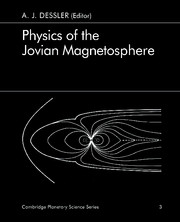Book contents
- Frontmatter
- Contents
- List of tables
- List of contributors
- Foreword
- Preface
- 1 Jupiter's magnetic field and magnetosphere
- 2 Ionosphere
- 3 The low-energy plasma in the Jovian magnetosphere
- 4 Low-energy particle population
- 5 High-energy particles
- 6 Spectrophotometric studies of the Io torus
- 7 Phenomenology of magnetospheric radio emissions
- 8 Plasma waves in the Jovian magnetosphere
- 9 Theories of radio emissions and plasma waves
- 10 Magnetospheric models
- 11 Plasma distribution and flow
- 12 Microscopic plasma processes in the Jovian magnetosphere
- Appendix A Symbols and acronyms
- Appendix B Coordinate systems
- Appendix C Jupiter and Io: selected physical parameters
- References
- Index
10 - Magnetospheric models
Published online by Cambridge University Press: 27 October 2009
- Frontmatter
- Contents
- List of tables
- List of contributors
- Foreword
- Preface
- 1 Jupiter's magnetic field and magnetosphere
- 2 Ionosphere
- 3 The low-energy plasma in the Jovian magnetosphere
- 4 Low-energy particle population
- 5 High-energy particles
- 6 Spectrophotometric studies of the Io torus
- 7 Phenomenology of magnetospheric radio emissions
- 8 Plasma waves in the Jovian magnetosphere
- 9 Theories of radio emissions and plasma waves
- 10 Magnetospheric models
- 11 Plasma distribution and flow
- 12 Microscopic plasma processes in the Jovian magnetosphere
- Appendix A Symbols and acronyms
- Appendix B Coordinate systems
- Appendix C Jupiter and Io: selected physical parameters
- References
- Index
Summary
Theoretical ideas concerning Jovian magnetospheric phenomena are at least as diverse as the phenomena themselves, and there presently exists no single comprehensive model that encompasses all known phenomena within a unified theoretical framework. We identify here a number of important theoretical concepts, some subset of which (together with perhaps others yet unidentified) will ultimately provide the elements of such a comprehensive model. A number of ideas have been advanced to account for the copious plasma source associated with Io, but none of these has yet accounted satisfactorily for both the magnitude and the morphology of the inferred source. Nevertheless, given the observed fact that Io supplies the bulk of the magnetospheric plasma mass, and the corollary that the net plasma transport is predominantly outward, it follows that the rotational energy of Jupiter is an important if not dominant source of energy for magnetospheric phenomena. This rotational energy is expended in a variety of phenomena, including the electrodynamic Io-Jupiter interaction and associated radio and auroral emissions, the acceleration of charged particles to MeV energies, and the generation of a wide variety of spin-periodic phenomena as observed both remotely and in situ. The spin periodicities observed within the magnetosphere can be explained for the most part as resulting from the diurnal wobble of the magnetospheric current sheet caused by the offset between Jupiter's magnetic dipole axis and its spin axis. However, remotely observed spin periodicities (the “pulsar” phenomena) apparently require the existence of an intrinsic longitudinal asymmetry in the Jovian magnetosphere that corotates with Jupiter.
- Type
- Chapter
- Information
- Physics of the Jovian Magnetosphere , pp. 353 - 394Publisher: Cambridge University PressPrint publication year: 1983
- 209
- Cited by



